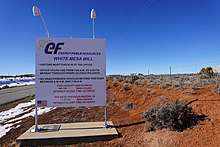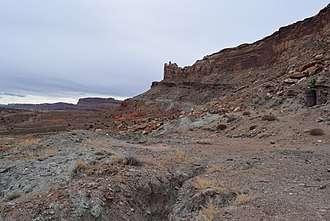Uranium mining in Utah
Uranium mining in Utah, a state of the United States, has a history going back more than 100 years. Uranium mining started as a byproduct of vanadium mining about 1900, became a byproduct of radium mining about 1910, then back to a byproduct of vanadium when the radium price fell in the 1920s. Utah saw a uranium boom in the late 1940s and early 1950s, but uranium mining declined in the 1980s. Since 2001 there has been a revival of interest in uranium mining, as a result of higher uranium prices.
Uravan mineral belt
Mining of uranium-vanadium ore in southeast Utah goes back to the late 19th century, at the northern end of the Uravan mineral belt (see Uranium mining in Colorado), where it crosses into Grand County, Utah. Uranium occurs in the Salt Wash member of the Morrison Formation of Jurassic age. Because much of the value depended on the vanadium content, the only economic ore minerals were carnotite and tyuyamunite. Following World War II buying for nuclear weapons programs made uranium valuable for its own sake, and attracted hundreds of prospectors to southeast Utah.[3]
Lisbon Valley

Uranium was discovered in sandstone of the Chinle Formation in Lisbon Valley, San Juan County in 1913, and some carnotite was mined on a small scale for vanadium in 1917, 1940, and 1941. In the uranium mining boom of 1948, mining began in sandstone of the Permian Cutler Formation. Then in 1952, Charles Steen drilled into a rich 70-foot-thick (21 m) uraninite orebody in the Triassic Chinle Formation; that type of deposit became the largest producer in the district. Ore is distributed along 15 mi (24 km) of outcrop on the southwest side of the Lisbon valley anticline. The district produced 49 million pounds (22 kt) of U3O8 (uranium oxide) through 1965.[4]
On November 4, 2016, a historical marker commemorating the Lisbon Valley's uranium heritage and noting Charlie Steen's discovery was dedicated on the Anticline Overlook road off U.S. 191. The marker was funded entirely by private donations. Artist Michael Ford Dunton created an arch to frame the historical marker and the view to the location of the Mi Vida mine, seven miles (11 km) to the east of the marker.[5]
White Canyon and Monument Valley districts

Uranium associated with copper mineralization at the White Canyon district was identified in 1920, but production did not begin until 1946. The geology is similar to that of the Monument Valley uranium district 40 mi (64 km) to the south which straddles the Utah/Arizona state line (see Uranium mining in Arizona). Uranium occurs in the Shinarump Member[6] of the Triassic Chinle Formation. Primary ore minerals are uraninite and coffinite. Through 1965, the White Canyon district produced 10 million pounds (4.5 kt) of U3O8.[7]
In 2009 White Canyon Uranium opened the Daneros underground mine, 40 miles west of Blanding in the White Canyon District, trucking ore to Denison Mines's White Mesa Mill. Daneros was the first new uranium mine permitted in Utah since the 1980s. In 2011 Denison took over White Canyon Uranium.[8] In 2012 Energy Fuels acquired the Daneros mine from Denison.[9] Energy Fuels produced from the Daneros mine until October 2012, at which time the mine was placed on standby, care, and maintenance.[10]
Marysvale district
At the Marysvale district, in Piute and Sevier counties, uranium occurs in hydrothermal veins in igneous rocks (quartz monzonite, latite porphyry, and aplite). Primary uranium minerals are uraninite and umohoite, with associated gangue minerals pyrite, fluorite, quartz, and adularia.[11]
Silver Reef district
Uranium minerals were noted by 1881 in the silver mines at the Silver Reef/Harrisburg district, at Silver Reef, Washington County. No uranium was extracted until 1950, when a small shipment was made. The uranium occurs as carnotite along with copper mineralization and the silver mineral chlorargyrite in the Chinle Formation.[12] Uranium production has been minor.
Yellow Chief mine
Uranium was mined from tuffaceous conglomerate and sandstone of the Miocene Spor Mountain Formation at the Yellow Chief mine in the Thomas Range of Juab County. The uranium ore minerals were beta-uranophane, weeksite, and schroekingerite.[13]
Bingham Canyon copper mine
The Bingham Canyon Mine in Salt Lake County, a large porphyry copper mine, recovered 120,000 to 150,000 lb (54,000 to 68,000 kg) of uranium oxide each year from 1978 through 1989, as part of its copper mining operation.[14]
Recent activity

All of Utah’s numerous uranium mines closed prior to 2000 due to low uranium prices.
In late 2006, Denison Mines reopened the Pandora mine in the La Sal mining district of southeastern Utah.[15] Denison Mines received all the required permits from the state of Utah and the US Bureau of Land Management to reopen its Tony M uranium mine in the Henry Mountains. The Henry Mountains Complex (including the Tony M mine) is said to contain 12.8 million pounds (5.8 kt) of U3O8.[16]
In 2012 Energy Fuels Inc. acquired all of Denison Mines uranium properties located in the United States,[17][18] including the White Mesa Mill.[19][20] The White Mesa Mill, located near Blanding, Utah, is the only conventional uranium (and vanadium) mill operating in the United States.
The Pandora mine and Henry Mountains Complex, in addition to the Beaver and Daneros mines, were placed on standby, care and maintenance by Energy Fuels in the fall of 2012.[21]
See also
- Moab uranium mill tailings pile
- Uranium mining in the United States
- Uranium mining and the Navajo people
- The Navajo People and Uranium Mining
- The Return of Navajo Boy, a documentary film about Native Americans struggling with the legacy of uranium mining on their lands.
References
- Pinch, W. L. (1954). "Geology of the Shinarump No. 1 Uranium Mine, Seven Mile Canyon Area, Grand County, Utah" (PDF). Geological Survery Circular. 336. Retrieved 2020-03-17.
- "Shinarump Mine". Mineral Resource Data System (MRDS). USGS. Retrieved 2020-03-17.
- R.P. Fischer (1968) The uranium and vanadium deposits of the Colorado Plateau region, in Ore Deposits in the United States, 1933–1967, New York: American Institute of Mining, Metallurgical, and Petroleum Engineers, p.738.
- Hiram B. Wood (1969) Geology and Exploitation of Uranium Deposits in the Lisbon Valley Area, Utah, in Ore Deposits of the United States, 1933–1967, v.1, New York: American Institute of Mining Engineers, p.770-799.
- Marcello, Molly (27 October 2016). "New historical marker installed near Lisbon Valley mine site commemorates region's complex uranium heritage". The Times-Independent. Moab, UT. Retrieved 22 November 2016.
- "Shinarump Member of Chinle Formation". Colorado River Basin Stratigraphy. USGS. 2006-05-06. Retrieved 2011-01-10.
- Roger C. Malan (1969) The Uranium Mining Industry and Geology of the Monument Valley and White Canyon Districts, Arizona and Utah, in Ore Deposits of the United States, 1933–1967, v.1, New York: American Institute of Mining Engineers, p.790-804.
- Peters, Douglas C. (2 March 2018). "Updated Report On The Daneros Mine Project, San Juan County, Utah, U.S.A." (PDF). Denver, CO: Energy Fuels Inc. Retrieved 16 May 2019.
- "Energy Fuels Inc., 2012 Annual Information Form" (PDF). Archived from the original (PDF) on 2013-10-19.
- Reuters. "Energy Fuels to Focus on Lower Cost Uranium Production". Archived from the original on 2015-09-24. Retrieved 2017-07-03.
- Paul F. Kerr and others (1957) Marysvale, Utah, Uranium Area, Geological Society of America, Special paper 64.
- Frederick Stugard Jr. (1951) Uranium Resources in the Silver Reef (Harrisburg) District, Washington County, Utah, US Geological Survey, Open-File Report 51-41.
- David A. Lindsey (1982) Tertiary Volcanic Rocks and uranium in the Thomas range and Northern Drum Mountains, Juab County, Utah, US Geological Survey, Professional Paper 1221.
- Technologically enhanced Naturally Occurring Radioactive Materials from Uranium Mining v.1, US Environmental Protection Agency, EPA 402-R-05-007, p.1-17.
- R.L. Bon and K.A. Krahulec, Utah, Mining Engineering, May 2007, p.121.
- "Energy Fuels Inc., Technical Report on the Henry Mountains Complex, June 27, 2012" (PDF).
- "Energy Fuels Inc., 2012 Annual Information Form" (PDF). Archived from the original (PDF) on 2013-10-19.
- Associated, Press. "Energy Fuels to buy Utah's White Mesa urnaium mill". The Denver Post.
- "Energy Fuels Inc., 2012 Annual Information Form" (PDF). Archived from the original (PDF) on 2013-10-19.
- Associated, Press. "Energy Fuels to buy Utah's White Mesa uranium mill". The Denver Post.
- "Energy Fuels to Focus on Lower Cost Uranium Production". Archived from the original on 2015-09-24. Retrieved 2017-07-03.
